The New York City Ballet presents an evening of ballets by August Bournonville.
In 1930, the year following the death of Serge Diaghilev and the dissolution of his company, Les Ballets Russes, its dancers and choreographers roamed Europe in search of jobs. After a stint in London, George Balanchine found work in Copenhagen as a guest choreographer for the Royal Danish Ballet, where he set or re-choreographed six ballets by Ballets Russes choreographers —four by Mikhail Fokine and two by Leonide Massine. (I’d like to have seen his take on Sheherazade.) He also presented evenings of his own ballets and appeared in a pièce d’occasion (a duet and a trio).
Patience. The facts I’m recounting do lead to the New York City Ballet’s 2015 Spring Gala and ensuing Lincoln Center season. During Balanchine’s five months in Denmark, he saw—probably for the first time—ballets by Denmark’s great 19th-century choreographer, August Bournonville, and observed the classes in Bournonville technique. The busy footwork, the many jumping steps, and the modest, unaffected performing style must have appealed to him—perhaps influenced him. Although Bournonville, unlike Balanchine, preferred to tell stories in his ballets, the dancing itself never depicted anger or struggle. For him it was part of a festive occasion, or an expression of ebullience, or a way of life for supernatural beings. Strong emotions were conveyed by acting or mimetic gestures.
In the 1960s, Balanchine invited Stanley Williams, once a principal dancer with the RDB and a teacher in the company’s school, to come to New York and teach in the School of American Ballet. In 1977, he asked Williams to create Bournonville Divertissements, a collection of excerpts from the Danish ballets. The current Ballet Master, Peter Martins, who grew up in Copenhagen taking classes from Williams, danced in its premiere.
This season, the NYCB is reviving this delightful anthology (at any rate, four of its possible numbers), re-staged by Martins’s son, Nilas Martins, a former NYCB principal dancer (also trained by Williams). It shares the program with one of Bournonville’s greatest ballets, the 1836 La Sylphide, his version (with new music by Herman Severin Løvenskjold) of the Paris Opera’s 1832 stunner by ballerina Marie Taglioni’s father, Filippo.
This year’s Bournonville Divertissments is heavy on excerpts from the 1842 Napoli. The ballet begins with the Ballabile from Act I and closes with the Pas de Six and Tarantella from Act III’s wedding celebration. Bournonville was a man who relished escaping gravity. In the Ballabile for six couples and one principal pair, almost every springy step in the ballet lexicon gets its moment in the sun. The French names often signal their natures: ballonné, jeté, etc. And it’s not only a matter of rising and coming down; the dancers, whether skimming along in brisés volés or soaring into entrechats and cabrioles, beat their legs together with the speed of a bird’s wing flutters.
Their elevation is emphasized by the fact that often when they jump straight up, they hold their curved arms down at their sides; nothing detracts from the image of an explosion into the air of a rocket-sleek human being. And that simplicity emphasizes the generosity that’s conveyed when a dancer leaps into a slight turn—front leg straight, back leg bent in attitude—and opens her or his his arms, palms up, to the audience.
When I first saw Bournonville Divertissements (maybe in the 1980s), I thought that, despite Williams’s coaching, the performers still looked like NYCB dancers in terms of their their appetite for space and their often flying arms. This time, they’ve substituted for that “American” style a pleasure in buoyancy and a modest demeanor that would have surely have pleased Bournonville. And an important part of that is their ability to conjure up a society. The unfortunate backdrop (by Alain Vaes) suggests a gloomy, windowless studio, yet the performers pay attention to one another and kibitz—the men whispering and shifting around while the women step saucily out in a chain, and so on.
The principal dancers are treated as friends to be watched. And Erica Pereira and Allen Pfeiffer celebrate with them and for them, rushing offstage, but always returning. One thing about Bournonville’s choreography is that if the dancers are doing the steps splendidlly and in sympathy with Holger Simon Paulli’s music (led at the Gala by Danish guest conductor, Henryk Vagn Christensen), and if they have been directed well,—as they clearly have here— you think of them as people you’d like to meet.
It may have been difficult for Sara Mearns to modify her natural expansiveness and boldness in the well known pas de deux from Flower Festival in Genzano (all that’s left of that ballet). But she manages the requisite shyness quite charmingly. Her partner is Tyler Angle, and they communicate delight in each other’s company—alone in a misty sunset garden (by Vaes). In a Russian-style pas de deux, one of the partners traditionally leaves the stage while the other shows off. In this Bournnville duet, each watches approvingly when the other is expressing him/herself in a tricky little solo. Although Mearns, like the other women, wears modern pointe shoes, the choreography for the duet doesn’t emphasize balancing on one toe-tip for ages while her partner holds her up (that wasn’t so possible in the mid-19th century).
Even a pas de deux like this requires dramatic subtleties. Mearns and Angle haven’t quite mastered the timing of the little saunter they take together a couple of times; to Edvard Helsted’s supporting musical passage, she glances at her beau as they go along; when he notices that, she quickly turns her head away—not wanting to be caught gazing at him. That’s minor; the two of them capture the duet’s flirtatious, but fond relationship wonderfully well.
Bouronville choreographed the Pas de Six for his ballet Abdallah, but Hans Beck, his successor at the RDB thought that the last act of Napoli needed more dancing and interpolated it. The couple to be married, after all, survived their Act II separation, when she was transformed into a naiad for the sea king’s delectation. So each of her four women friends entertains the village with a wonderfully composed little solo, as do the two men. All the NYCB dancers (Lauren King, Rebecca Krohn, Megan LeCrone, Lauren Lovette, Adrian Danchig-Waring, and Amar Ramasar) perform with happy mastery all the steps that the occasion calls for. There’s also a nimble extra guy: Anthony Huxley. I’m particularly fond of the solo that Lovette performs, with its momentary, suspended balances on pointe (the music, by Helsted and Paulli, waits for her to come down).
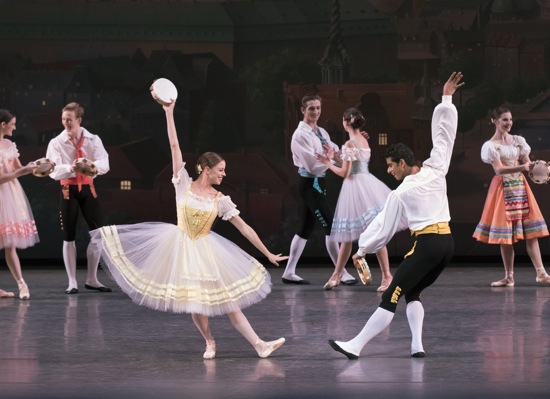
The Tarantella from Napoli. Foreground: Ashley Isaacs and Amar Ramasar. At back (L to R): Megan LeCrone, Austin Bachman, Harrison Coll, Lauren Lovette, and Indiana Woodward. Photo: Paul Kolnik
The entire cast is onstage for the Tarantella, with Angle and Mearns standing in for Teresina and her fisherman lover and rescuer, Gennaro. And almost everyone gets a tambourine to smack and shake in the lively celebration. Bournonville had enjoyed his sojourn in Naples (actually a temporary exile) and the colorful, hot-tempered, conniving, warm-hearted people he observed on the dockside. Their ebullience simmers into this wedding party. And the NYCB dancers set the stage a-boil.
This backdrop by Vaes is handsome, but strange. Judging from its view of Copenhagen from above, the party seems to be happening after a long hike up a mountain instead of in an ocean-side piazza.
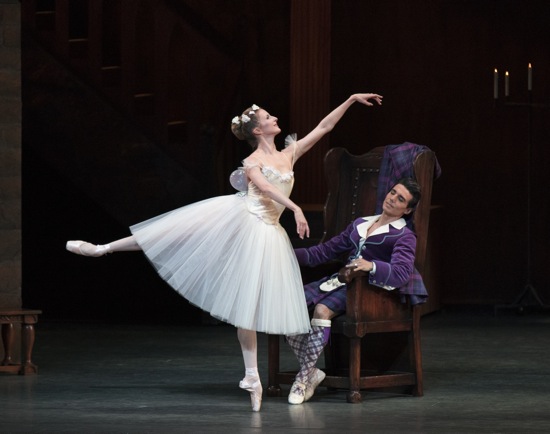
Sterling Hyltin as Bournonville’s Sylphide dances her love for the sleeping James (Joaquin De Luz). Photo: Paul Kolnik
On a trip to Paris in 1834, Bournonville had seen and been enchanted by Taglioni’s La Sylphide. Two years later, he mounted his own Sylphide for the Royal Danish Ballet to music Herman Severin Løvensjold. It is, I believe, the only tragic ballet he made and certainly the only surviving one. It has everything the Romantic Era prized: a restless hero with longings for something beyond humdrum village life; an unearthly temptress representing an unattainable ideal; and a conflict between desire and duty. That it’s set in Scotland shows how mysterious that country’s misty woods and fens could seem to a foreigner.
The NYCB dancers perform for the first time a Sylphide that Peter Martins staged in 1985 for the Pennsylvania Ballet. He knew the ballet well, having danced the role of the hero, James, in Copenhagen while a member of the RDB. In this sensitive and excellently re-staging, he was assisted by Petrushjka Bruholm, a former soloist with the Danish company.
Let me get my cavils out of the way. Susan Tammany’s set for Act I, the farmhouse where James and his fiancé, Effie, are to be married, is appropriate and handsome. On the other hand, her set for the forest that the dangerous sylph calls home looks as if it had been painted to back a tropical extravaganza—a mélange of vividly colored stylized foliage that works against the period scenario and atmosphere. Since this two-act ballet balances naturalism with the supernatural, you want “reality” to be, well, realistic (or I do). Costuming James in a purple tartan and a purple velvet jacket and other Scottish folk in similarly unusual colors and muted patterns didn’t strike me as ideal either. Finally, the, gray wig that Georgina Pazcoguin wears to play James’s nemesis, the witch Madge, seems overly voluminous.
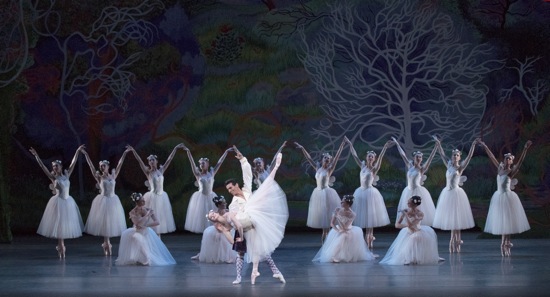
Sterling Hyltin, Joaquin De Luz, and the sylph’s companions in Act II of La Sylphide. Photo; Paul Kolnik
That’s it. I love La Sylphide, and the NYCB cast that I saw performs it with full-spirited vigor. Joaquin De Luz excels at the jumping steps that the role of James requires, and his acting—as a man torn between his proper bride and a creature of the air—is exemplary. That’s true also of another high-jumper, Daniel Ulbricht, as James’s friend Gurn (who wishes Effie were his bride and, in fact, gets her in the end). Pazcoguin’s Madge is terrifically evil, and I imagine her performance will become more nuanced and pointed as she continues to play the role. I was very impressed by Brittany Pollack’s interpretation of Effie, the bride-to-be whose groom rushes off into the woods on their wedding day in pursuit of an invisible (to her) nymph; she eloquently and without affectation conveys her happiness, her love of James, her bafflement over his behavior, and her grief.
James is the hero, but as in all the Romantic ballets with supernatural heroines, the tantalizing, yet apparently naïve—even childlike—sylph draws our attention. She is light as air, unwittingly dangerous; human beings puzzle her, but she wants James to come live with her in the forest. Sterling Hyltin beautifully captures this errant creature’s delight in the world of nature and her attraction to James as she watches him sleep in his armchair by the fire. She pantomimes two tears sliding down her cheeks when he “tells” her he is to be married today. But what are vows to her? She brings him his cap and rushes out the door, expecting him to follow.
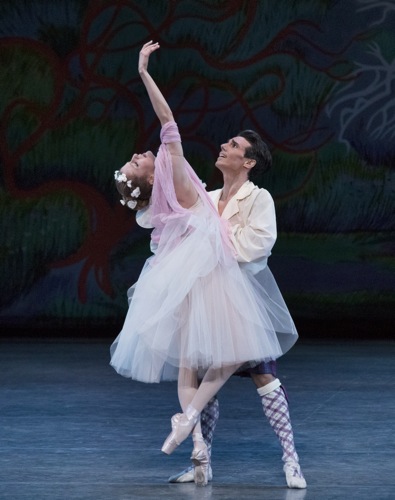
The sylph cannot be possessed, and her lover has unwittingly caused her to expire. Sterling Hyltin and Joaquin De Luz in the final moments of August Bournonville’s La Sylphide. Photo: Paul Kolnik
Hyltin’s dancing is as buoyant as one could wish. By underplaying the physical effort it takes to make her appear to be a creature of the air, she becomes truly ethereal. And her sweet efforts to succor James with birds’ eggs or slake his thirst with water carried carefully in her cupped hands come across vividly, as does James’s mystification with finding himself amid a bevy of white-clad spirits—any one of whom could be mistaken for his bolder pursuer.
Making a story clear and believable, however fantastic, was one of Bournonville’s gifts. A few children of the village join in one of the celebratory highland dances, and when little Maya Rosefsky partners with an adult in the celebratory highland dances, no one makes a big deal of it. Another of the children from the School of American Ballet, Andrew J. Denise, doubles as a rambunctious junior witch in Act II, all but climbing into the cauldron in which Madge and her colleagues (corps dancers Austin Bachman, Spartak Hoxha, and Ghaleb Kayali) are boiling up the magic scarf that will be the undoing of both James and the Sylph. He turned Madge away from his fireside, and she will be revenged.
Hyltin movingly shows her delight in the scarf that Madge gives to James. He teases her with it at first, then (this puzzles her) gets very serious, and you know what will happen. The scarf, when wrapped around her, will not turn her, as promised, into a real woman; her wings will fall off, and she will perish. Effie will marry Gurn that very day, and James, having let lust lead him to pursue the ungraspable, will be left with nothing, will, in fact, die.
When the Sylph is about to expire, she admonishes him with a barely pointing finger and very slightly and sorrowfully shakes her head, as if to say, “If only you had let me be what I was.” In this tale of magic and the supernatural, that image and all that it says about betrayal and forgiveness is here-and-forever real enough to bring tears to your eyes.

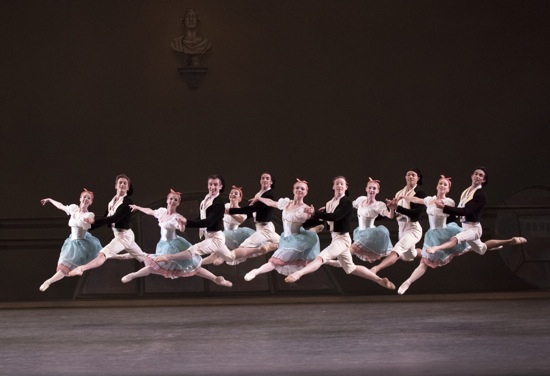
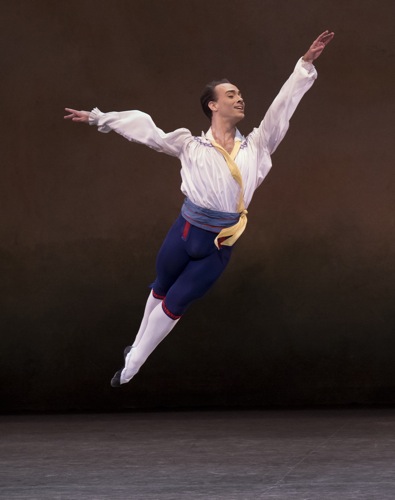
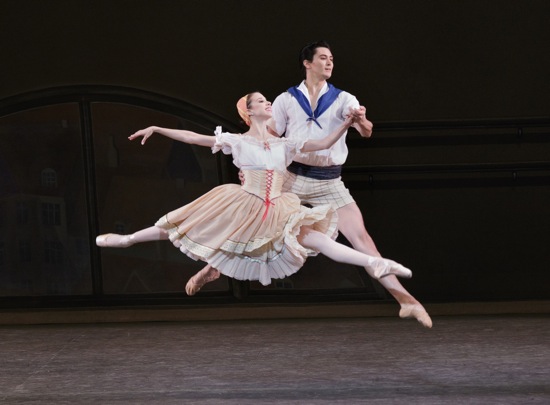
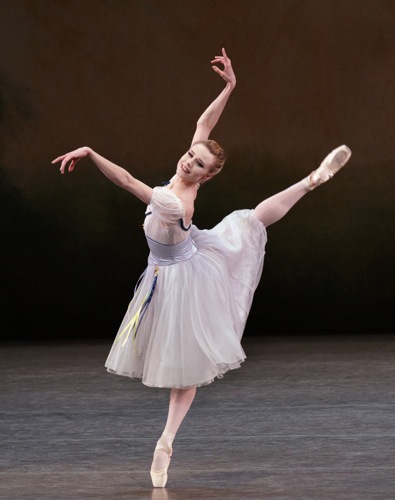
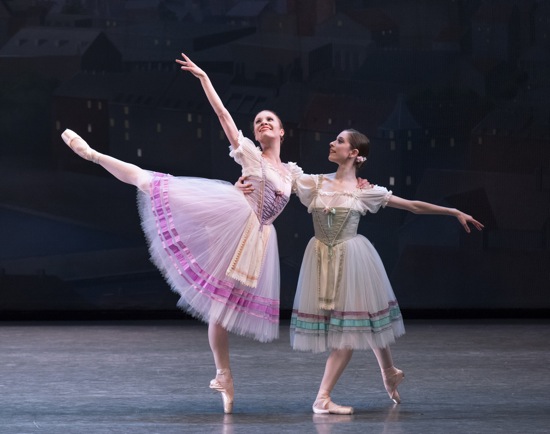
Thanks Deborah for a very cogent and informative review! I’m dying to see this program — and I remember seeing the 1980’s version at NYCB about which I had the same thoughts as you.
I’m wondering if Balanchine may not have experienced some Bournonville — or at least Bournonville-style — as passed on in Russian classroom by the Swedish teacher Johanssen, (sp?) who himself studied Bournonville and brought that style to “Theatre Street” as Karsavina calls it in St. Petersburg. I’m not sure that Johanssen was teaching or even alive by the time Balanchine entered the school — I have to check that out — but I suspect it was passed down to some extent by others who worked with him.
In any case, one of things that I’ve always admired about Mr. B. is his love of petit allegro and I THINK that may hark back to his link to earlier 19th century footwork (French as well as Danish) which must have come through in Russian classes (and not necessarily have been filtered through Petipa as most of the Giselles we see today are). I’m also thinking that Bournonville is the closest we might ever get to what French Romantic style REALLY looked like — which I think again, for us, has been filtered too much through Russian lenses. (The Lacotte revival of La Sylphide, with all that sustained point work certainly doesn’t give you many clues.) And, also because Levinson and others, privleged the “Taglioni” ethereal “ballet blanc” look and not Elssler’s bounce. Bournonville’s bouyancy and quick beating steps, as you point out, take on entirely different look when danced by the villagers of Napoli and the participants in the flower festival. (Mary Clarke once told me a story about a colleague of hers who said that an ideal death would be to collapse in the lobby of the Royal Theater in Copenhagen just after seeing the Tarentella in Napoli — so that you died happy and never knew what hit you!)
Thanks Deborah…Fabulous piece. Finally a review that gives the program the thoughtful analysis it deserves and notes the wonderful way these great dancers tried to live up to a style not native to them. This is an important program for audiences to see. Hopefully many will read this and come.
One must be careful making generalizations about an artist like Bournonville, only a few of whose ballets have survived. Most of his ballets are indeed “upbeat,” but he was a far more varied choreographer than we might recognize from the works we now see. There are violent battle scenes is several now forgotten ballets, such as Waldemar (1835) and The Valkyrie (1861), while The Lay of Thrym (1868) concerns the downfall of the gods, to take three that had a long theatre presence. For a fuller overview, see Patricia McAndrew’s translations of his “ballet poems” in Dance Chronicle, vols. 3/2-6/1 (available online through libraries) and also of his remarkable autobiography, My Theatre Life.
A few notes: First, I think the city in Vaes’ third backdrop is clearly Copenhagen. Then, does James really feel “lust” toward the sylph or is she an unattainable symbol of another life than the humdrum one of a Scottish farmer? And finally, Johansson died in 1903, a year before Balanchine was born, but clearly his teaching endured in the Imperial School.
With George Dorris and Beth Genne weighing in you don’t need me, but I did think I would tell you that when we were all in Copenhagen in 2005, I was walking around the photo gallery in the Royal Theater with Tobi Tobias and she was telling me how much Balanchine loved those dancers in 1930. French Romantic style or not, I associate Bournonville with a warm embrace from the dancers to the audience, and I sure as hell don’t associate that with any other company but the RDB. I’m hoping that Oregon Ballet Theatre dancers, who are doing Act III of Napoli next fall, will get that, and I’m thinking, after watching Frank Andersen work with some of them in February, that specific ones, a couple of the young men, definitely will. Anyway, it’s a lovely piece and I thank you for it.